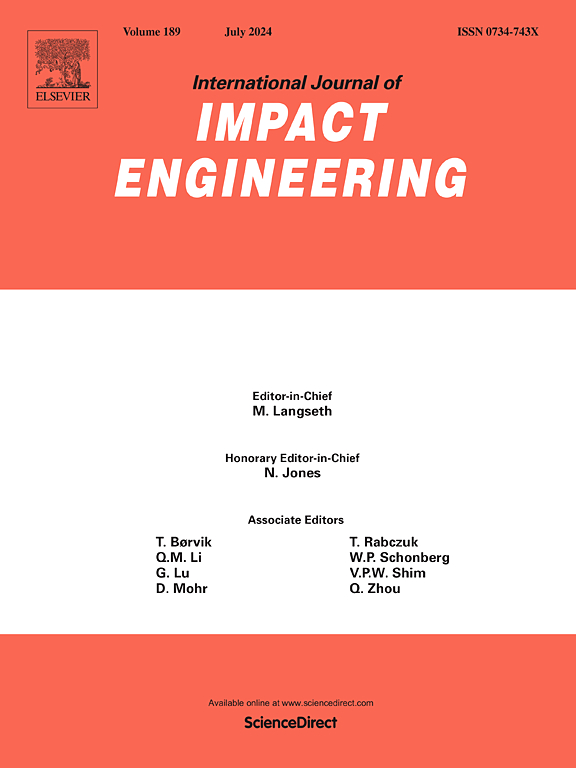Determination of dynamic flow stress equation based on discrete experimental data: Part 2 dynamic flow stress depending on strain, strain-rate and temperature
IF 5.1
2区 工程技术
Q1 ENGINEERING, MECHANICAL
International Journal of Impact Engineering
Pub Date : 2025-06-07
DOI:10.1016/j.ijimpeng.2025.105432
引用次数: 0
Abstract
In this study, the effects of strain, strain-rate and temperature on the flow stress of C54400 phosphor copper alloy is investigated experimentally. Artificial neural network (ANN) is used to train the qualified data from the split Hopkinson pressure bar (SHPB) tests, obtaining finely-filled flow stress array (an order-three tensor). CANDECOM/PARAFAC (CP) decomposition method is used to decompose the flow stress array, from which both discrete and analytical expressions of flow stress equations are obtained. It is found that the analytical flow stress equation () based on CP Rank-2 decomposition agrees well with the finely-filled data from ANN. Most importantly, the thermal softening effect of the C54400 material is well reproduced by . Finally, is compared with the flow stress equation () obtained by following the conventional method to determine the dynamic flow stress. Results show the excellent performance of in flow stress prediction from low to high temperatures while fails in the high temperature range. The comparison demonstrates the effectiveness of the proposed framework in the determination of dynamic flow stress equations.
基于离散实验数据的动态流变应力方程的确定:第二部分:随应变、应变速率和温度变化的动态流变应力
实验研究了应变、应变速率和温度对C54400磷铜合金流变应力的影响。利用人工神经网络(ANN)对分离式霍普金森压杆(SHPB)试验的合格数据进行训练,得到细填充流应力阵列(一个三阶张量)。采用CANDECOM/PARAFAC (CP)分解方法对流动应力阵列进行分解,得到流动应力方程的离散表达式和解析表达式。发现基于CP Rank-2分解的解析流变应力方程(f(ε,ε˙,T)Ana_R2)与人工神经网络的精细填充数据吻合较好。最重要的是,f(ε,ε˙,T)Ana_R2能很好地再现C54400材料的热软化效应。最后,将f(ε,ε˙,T)Ana_R2与常规流动应力测定方法得到的流动应力方程(f(ε,ε˙,T)MJC)进行比较。结果表明,f(ε,ε˙,T)Ana_R2在低温到高温范围内具有良好的流动应力预测性能,而f(ε,ε˙,T)MJC在高温范围内表现不佳。对比结果表明,所提出的框架在确定动态流动应力方程方面是有效的。
本文章由计算机程序翻译,如有差异,请以英文原文为准。
求助全文
约1分钟内获得全文
求助全文
来源期刊

International Journal of Impact Engineering
工程技术-工程:机械
CiteScore
8.70
自引率
13.70%
发文量
241
审稿时长
52 days
期刊介绍:
The International Journal of Impact Engineering, established in 1983 publishes original research findings related to the response of structures, components and materials subjected to impact, blast and high-rate loading. Areas relevant to the journal encompass the following general topics and those associated with them:
-Behaviour and failure of structures and materials under impact and blast loading
-Systems for protection and absorption of impact and blast loading
-Terminal ballistics
-Dynamic behaviour and failure of materials including plasticity and fracture
-Stress waves
-Structural crashworthiness
-High-rate mechanical and forming processes
-Impact, blast and high-rate loading/measurement techniques and their applications
 求助内容:
求助内容: 应助结果提醒方式:
应助结果提醒方式:


